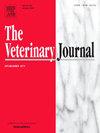Population pharmacokinetics and clinical evaluation of intravenous acetaminophen and its metabolites in Andalusian horses
IF 3.1
2区 农林科学
Q1 VETERINARY SCIENCES
引用次数: 0
Abstract
To date, no intravenous pharmacokinetics (PK) studies have assessed acetaminophen or its major metabolites (acetaminophen-glucuronide and acetaminophen-sulphate) in horses. The influence of sex on acetaminophen metabolism in horses is unclear, and Monte Carlo simulations have not been applied to explore potential clinical applications. This study aimed to determine the intravenous PK and safety of acetaminophen in Andalusian horses at 10 and 20 mg/kg, evaluate sex as a covariate, and simulate clinical regimens. Twenty mares and twenty stallions received intravenous acetaminophen, and plasma concentrations were analysed by LC-MS/MS and modelled using non-linear mixed-effects models (MonolixSuite®). Safety was evaluated via clinical examinations and by haematological and biochemical profiles 24 h after administration. Two constant-rate infusion (CRI) regimens were examined in PK simulations that did not involve surgery: a short-duration, high-dose infusion (3 h) for peri-operative scenarios (short-infusion group at 3.33, 6.66, and 10.0 mg/kg/h) and a longer-duration, lower-dose infusion (8 h) for post-operative analgesia scenarios (long-infusion group at 1.25, 2.50, and 3.75 mg/kg/h). After modelling, glucuronide and sulphate levels were 2.1 and 4.53 times higher, respectively, than acetaminophen levels. Half-lives were 3.5, 5.6, and 3.2 h for acetaminophen, glucuronide, and sulphate, respectively. Clearance was influenced by sex (mares: 0.47 L/h/kg; stallions: 0.35 L/h/kg). No adverse effects were observed. Steady-state concentrations observed in the CRI simulations ranged from 1.75–5.21 µg/mL (short-infusion group) and 0.62–2.02 µg/mL (long-infusion group). Acetaminophen exhibited sex-dependent PK variability and high-level formation of metabolites. These findings support further clinical evaluation of acetaminophen CRIs in equine analgesia.
安达卢西亚马静脉注射对乙酰氨基酚及其代谢物的人群药代动力学和临床评价
迄今为止,还没有静脉药代动力学(PK)研究评估对乙酰氨基酚或其主要代谢物(对乙酰氨基酚-葡萄糖醛酸盐和对乙酰氨基酚-硫酸盐)在马体内的作用。性别对马对乙酰氨基酚代谢的影响尚不清楚,蒙特卡罗模拟尚未应用于探索潜在的临床应用。本研究旨在确定10和20 mg/kg对乙酰氨基酚在安达卢西亚马静脉注射时的PK和安全性,评估性别作为协变量,并模拟临床方案。20匹母马和20匹种马静脉注射对乙酰氨基酚,采用LC-MS/MS分析血浆浓度,并采用非线性混合效应模型(MonolixSuite®)建模。给药后24 h通过临床检查和血液学和生化指标评估安全性。在不涉及手术的PK模拟中,研究了两种恒速输注(CRI)方案:围手术期的短时间、高剂量输注(3 h)(短时间输注组为3.33、6.66和10.0 mg/kg/h)和术后镇痛场景的长时间、低剂量输注(8 h)(长时间输注组为1.25、2.50和3.75 mg/kg/h)。在建模之后,葡萄糖醛酸和硫酸盐的含量分别是对乙酰氨基酚的2.1倍和4.53倍。对乙酰氨基酚、葡萄糖醛酸和硫酸盐的半衰期分别为3.5、5.6和3.2 h。清除率受性别影响(母马:0.47 L/h/kg;马:0.35 L / h /公斤)。未观察到不良反应。在CRI模拟中观察到的稳态浓度范围为1.75-5.21 µg/mL(短时间注射组)和0.62-2.02 µg/mL(长时间注射组)。对乙酰氨基酚表现出性别依赖的PK变异性和高水平的代谢物形成。这些发现支持对乙酰氨基酚CRIs在马镇痛中的进一步临床评价。
本文章由计算机程序翻译,如有差异,请以英文原文为准。
求助全文
约1分钟内获得全文
求助全文
来源期刊

Veterinary journal
农林科学-兽医学
CiteScore
4.10
自引率
4.50%
发文量
79
审稿时长
40 days
期刊介绍:
The Veterinary Journal (established 1875) publishes worldwide contributions on all aspects of veterinary science and its related subjects. It provides regular book reviews and a short communications section. The journal regularly commissions topical reviews and commentaries on features of major importance. Research areas include infectious diseases, applied biochemistry, parasitology, endocrinology, microbiology, immunology, pathology, pharmacology, physiology, molecular biology, immunogenetics, surgery, ophthalmology, dermatology and oncology.
 求助内容:
求助内容: 应助结果提醒方式:
应助结果提醒方式:


